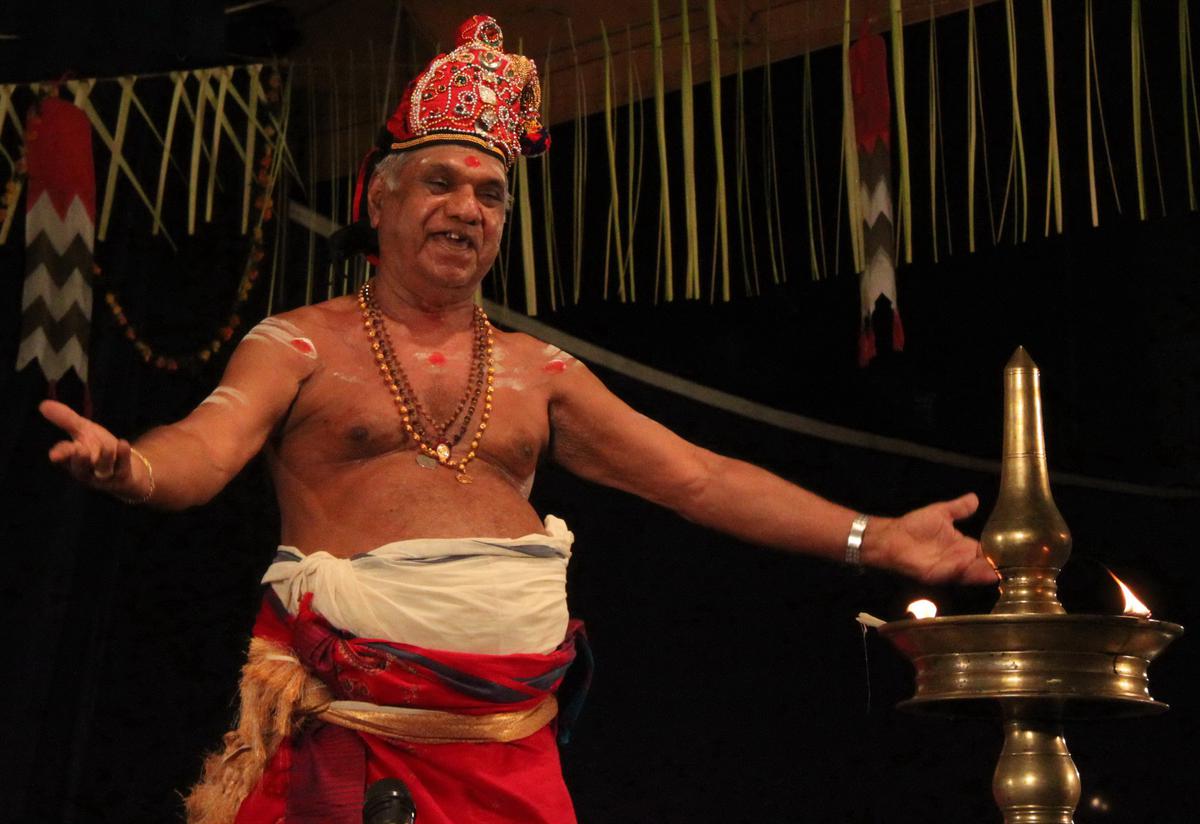P.K. Narayanan Nambiar.
| Photo Credit: The Hindu Archives
One of the reasons why the The United Nations Educational, Scientific and Cultural Organization (UNESCO) recognised Koodiyattam, the sole surviving traditional Sanskrit theatre, as an oral and intangible heritage of humanity way back in 2001 is its indisputable antiquity.
Ever since its first onstage performance believed to be held between the 10th and 11th Centuries AD, Koodiyattam remained the prerogative of the Chakyars and the Nambiars. In 1965, it was added to the curriculum of Kerala Kalamandalam.
While the progressive-minded or, more precisely, the radically-inclined Painkulam Rama Chakyar headed the faculty of acting there, P.K. Narayanan Nambiar was appointed the instructor for Mizhavu, the principal percussion-instrument of Koodiyattam. The veteran, who passed away recently, was undoubtedly the modern architect of Mizhavu-music, besides being a scholar and writer.
As the son of the legendary Koodiyattam actor Mani Madhava Chakyar, Narayanan Nambiar had inherited many a distinctive quality associated with the artform and its iconic practitioners. He grew up in an environment watching the recitals of well-known Chakyars and Nangiars. Yet he had to wait until the mid- 20th Century to find a democratic platform to hone his talents, and to disseminate his knowledge on Mizhavu.
Within the Koodiyattam-Kalari of Kerala Kalamandalam, Narayanan Nambiar systematised and restructured the form and content of Mizhavu-music. He single-handedly codified and classified its functional significance in accordance with the angika (movement dynamics), vachika (verbal acting) and satwika (emotive acting) of the actors trained by Rama Chakyar.
The training methodology introduced by him solidified the pedagogy of Mizhavu-music in the years to come.
In his own Kalari, Narayanan Nambiar imparted lessons on the Mizhavu to a handful of highly-skilled youngsters, who later joined their guru in the Cholliyattakkalari (performance without make-up and costumes) to temper their talents in tune with the texts, contexts and the characters. In the course of time, most of his disciples became masters in the field. All the noted Mizhavu players of the day hold aloft the idiom carved out by him.

A Patakam performance by Mizhavu exponent PK Narayanan Nambiar.
| Photo Credit:
The Hindu Archives
Traditionally, there are only two tala-patterns in Koodiyattam and Nangiarkoothu — Ekam (1 beat) and Thriputa (7 beats). Narayanan Nambiar had an irresistible urge to go beyond, and composed a new genre — Mizhavil Thayambaka (a solo recital on the Mizhavu). The instrument is capable of producing only two sounds — tha and thom. Its leather-surface does not offer space for creating other sounds. Modulation, too, is difficult. Yet, Narayanan Nambiar and his immediate disciples, Kalamandalam Eswaran Unni and Hariharan, conducted a Thayambaka on it, crossing over to different tala-patterns — panchari (six beats), chamba (10 beats) and adantha (14 beats). Their deft playing proclaimed the potentials of this instrument even outside the boundaries of Koothu, Koodiyattam and Nangiarkoothu.
Well-conversant with the plays of Kalidasa, Shaktibhadra, Bhasa, Sreeharsha, Neelakanta, Kulasekhara, Bodhyana and the like, Narayanan Nambiar knew all the nuances associated with the acting techniques. Little wonder, his Mizhavu playing displayed a profound visual sensibility, so much so that young actors depended on him to hone their skills.
Positioned behind the nayakas, nayikas and the prathinayakas in Koodiyattam, Narayanan Nambiar never attempted either to outsmart outstanding actors or ignore the lesser ones. While playing the instrument for each of them, he spontaneously read their performances with a critical eye and was ready to offer guidance off stage. Ouchithya (propriety) was the hallmark of his artistry on stage.
Sreekrishnacharitam Nangiarammakuttu is one of the monumental works of Narayanan Nambiar that is hailed both by practitioners of the art form and scholars. Even after his retirement from Kalamandalam as professor and Head of the Faculty of Mizhavu, he spared no efforts to not only revamp Koodiyattam but Patakam (a solo vocal rendition similar to that of koothu) too.
Narayanan Nambiar stayed throughout his life in Killikkurissimangalam in Palakkad district, a place that has given birth to a host of great artistes and scholars in the last century. With his astounding memory, Nambiar could recollect the texts of Koothu, Koodiyattam and Patakam both on and off stage. He was conferred the Padma Shri, and a recipient of the Central and State Sangeet Natak Akademi awards and fellowships, besides several other National and State-level honour.